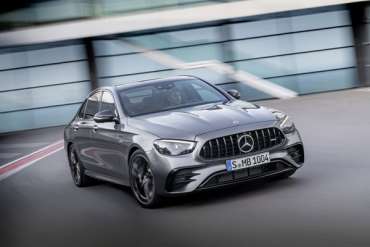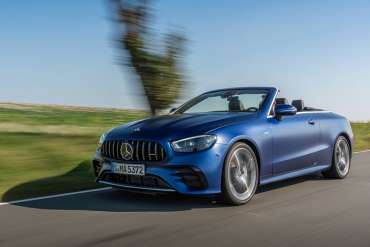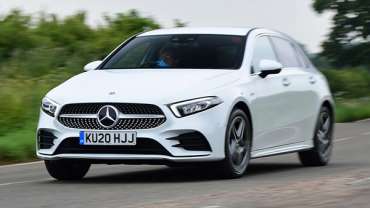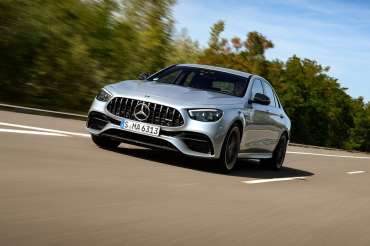Displaying items by tag: Mercedes
Mercedes-AMG E 53 2021 Launched With 423BHP
Mercedes has unveiled an updated version of its entry-level AMG E 53 performance saloon, hot on the heels of the facelifted standard E-Class range. The brand’s updated rival for the Audi S6 is on sale in the UK now, with prices starting from £64,750 for the saloon and £66,750 for the estate.
The updated AMG E 53 4MATIC+’s styling tweaks mirror those of the standard E-Class range, albeit with a more hardcore appearance. Up front, there’s a new radiator grille which mimics the design of the AMG GT Coupe’s – and at the rear, there’s an aggressive new diffuser which houses a quad-exit exhaust system.
The E 53 is available in a choice of two trim levels. The base model features 19-inch twin-five-spoke AMG alloy wheels, a 360-degree parking camera, keyless go and AMG-branded brake calipers. Inside, buyers get a pair of leather-trimmed sports seats, carbon-fibre trim and Mercedes’s 12.3-inch dual-screen infotainment system.
The E 53’s infotainment set-up also includes AMG-specific functions, such as a lap timer, telemetry settings and track mapping. There’s a new flat-bottomed steering wheel, which is similar in design to the rest of the range, but is fitted with a pair of AMG buttons to adjust the car’s driving modes.
The more lavishly equipped AMG E 53 Night Edition Premium Plus is priced from £68,250 and adds a set of matte-black 20-inch alloy wheels, a panoramic glass sunroof, privacy glass, gloss-black window surrounds and an improved 13-speaker Burmester sound system.
Both E53s are powered by a turbocharged 3.0-litre straight-six petrol engine, which is supported by a 48-volt mild-hybrid system. Combined, the unit has an output of 423bhp and 520Nm of torque which, thanks in part to the car’s four-wheel drive system, is enough for a 0–62mph time of 4.5 seconds and a top speed of 155mph.
Like all Mercedes-AMG models, the E 53 gets a host of extra chassis technology, including adaptive dampers, a sophisticated five-stage traction control system, uprated disc brakes, dynamic engine mounts and a limited-slip differential for the rear axle. Read more > https://mercedes-world.com/e-class/mercedes-amg-e-53-launched
Source: mercedes-world.com
2021 Mercedes-AMG E53 Cabriolet Delivers Both Speed and Grace
A freshened face and additional features adorn AMG's updated droptop E-class, but its high-tech inline-six remains as sweet as ever.
The hierarchical nature of model positioning means it is easy to view the 2021 Mercedes-AMG E53 as less desirable than the AMG 63 S sitting above it in the E-class range. Yet, such a judgement is unfair. The considerable talents of AMG's gently electrified six-cylinder give it a different character than the range-topping V-8 but one that's almost as equally compelling. In those variants where both powerplants are offered, it is entirely justified to prefer the smaller engine on grounds other than sheer parsimony. With the stylish E-class cabriolet, however, the point is moot. The AMG E53 is where the convertible tops out.
Some will bemoan AMG's continued refusal to combine the sonorous muscularity of its twin-turbo 4.0-liter V-8 with the cabriolet body. But the electrically assisted 3.0-liter inline-six of the AMG E53 proves almost perfectly suited to the car's laid-back driving manners. A mid-term facelift for 2021 hasn't wrought any significant mechanical revisions—power and torque figures remain unchanged—but it has brought more toys and revised styling to the range-topping cabriolet.
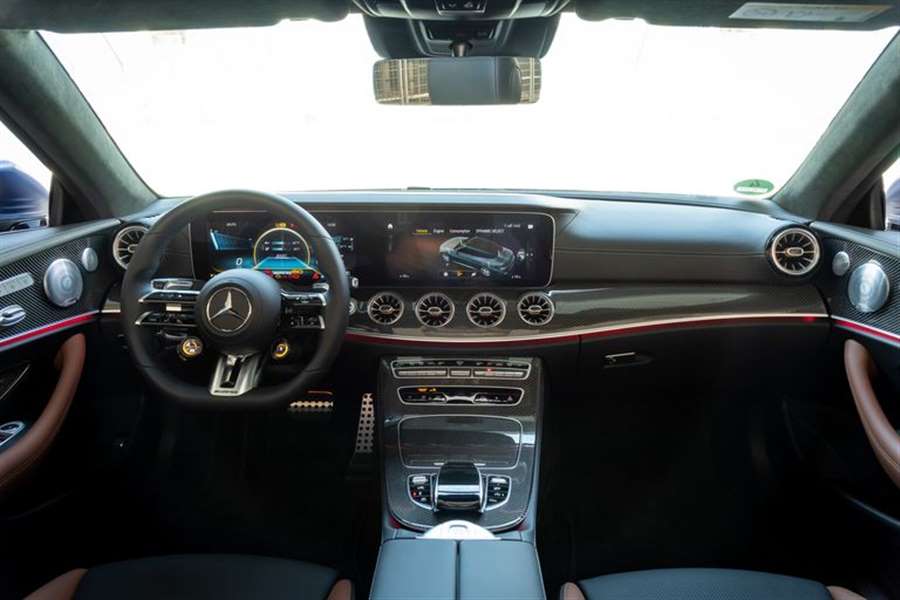
As with the E-class sedan and wagon, the cabriolet and closely related coupe get a heavily revised front end with new headlights and a radiator grille apparently inspired by the W194 300SL racer that won the Carrera Panamericana in 1952. Narrowed at the top and wider at the bottom, this is effectively an inverse of the pre-facelift grille and one that we think better suits the car. Changes at the rear end have been more limited, the E-class cabriolet (and its coupe counterpart) getting taillights with new internal elements. As before, the AMG E53 gets quad exhaust pipes beneath the rear bumper. The lesser E450 makes do with slightly squashed-looking dual exhaust tips.
More obvious changes are evident in the cabin, which remains spacious and extremely well-finished but which has migrated to the latest version of Mercedes's MBUX infotainment system. This is certainly crisper looking than the old setup and adds high-tech features like augmented-reality navigation, which superimposes direction-pointing arrows onto a live video feed when approaching intersections, but we found the system lacking in intuitive smarts and sometimes complicated to operate. Mercedes also gave the E53 a new four-spoke steering wheel to provide real estate for a proliferation of touch-sensitive controls, many of which replicate functions still served by surviving pre-facelift buttons. Buyers will doubtless get used to the complexity—or shortcut it with the smart "Hey, Mercedes" voice assistant—but we are increasingly nostalgic for the recent past when Benz's user interface was both simple and intuitive.
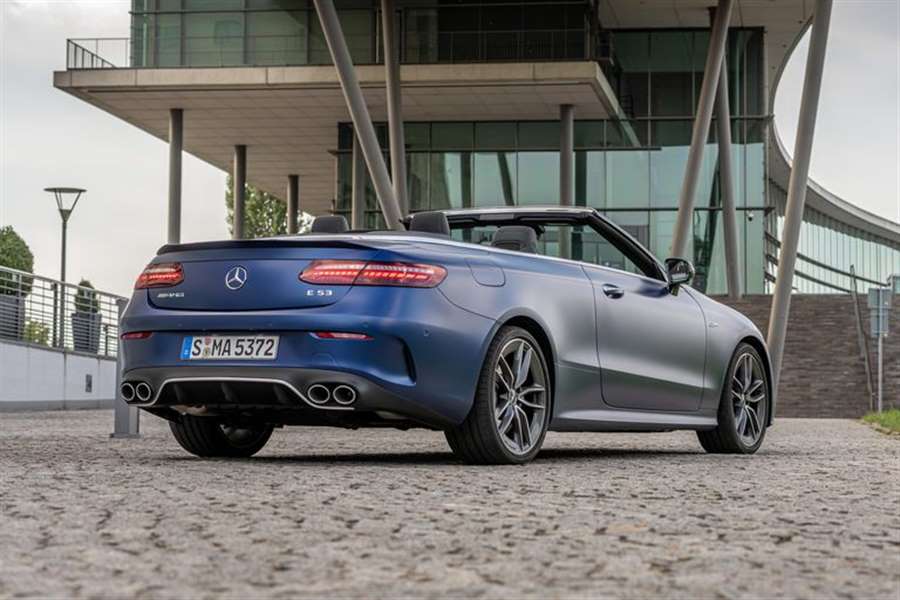
Beyond mild ergonomic niggles, the rest of the driving experience impresses all the way. The E53 powertrain continues to use a very clever 3.0-liter inline-six that has both a conventional exhaust-driven turbocharger and an electrically powered 48-volt compressor that adds boost at lower engine revs. The six is paired with a substantial integrated starter-generator that, although it can't power the car by itself, is able to add up to 21 horsepower and 184 pound-feet of torque to the combustion engine's output of 429 horsepower and 384 pound-feet. (The lesser E450 uses the same engine and starter-generator but lacks the e-turbo.)
The powertrain's complexity remains effectively invisible. All the E53 driver will experience is the combination of effortless low-rev muscle—with a total absence of detectable lag—and an impressively bristly top end. No, the six-cylinder can't match either the firepower or theatrics of the E63 S, but it is still able to deliver forceful acceleration when unleashed. The last E53 coupe that we tested blasted its way from zero to 60 mph in just 4.1 seconds, and we expect about the same for the slightly heavier cabriolet. Only at high speeds does the E53 start to feel anything less than blisteringly quick. On a stretch of limit-free German autobahn on our test route, the rate of acceleration fell away above an indicated 125 mph, a speed at which the E63 S sedan kept pulling at a barely diminished rate. While obviously lacking a V-8 soundtrack, the E53 makes some impressively muscular noises under hard use, with the Sport and Sport Plus modes allowing for some pops and crackles on upshifts and when the accelerator is lifted at higher revs.
The punchier dynamic modes sharpen the rest of the E53 driving experience, too, although not one turns it into a true sports car. Air springs and adaptive dampers are firmed up in the more aggressive settings but not sufficiently to corrupt the cabriolet's ride. Nor does the body control feel wayward in Comfort mode, the cabrio's 4600-pound mass kept in check over the roughest surfaces we could find. The weight is more obvious when asking the car to change direction quickly, and with the cabriolet's roof stowed we did notice slight evidence of the car's weakened structure, the rearview mirror vibrating slightly over certain road surfaces. The cabriolet's steering delivers crisp cornering response, although little natural feel passes beyond the generous power assistance. Traction from the quick-acting 4Matic all-wheel-drive system is impeccable on dry pavement. It takes an unsympathetic level of abuse to persuade the E53 to relinquish any rear-end grip.
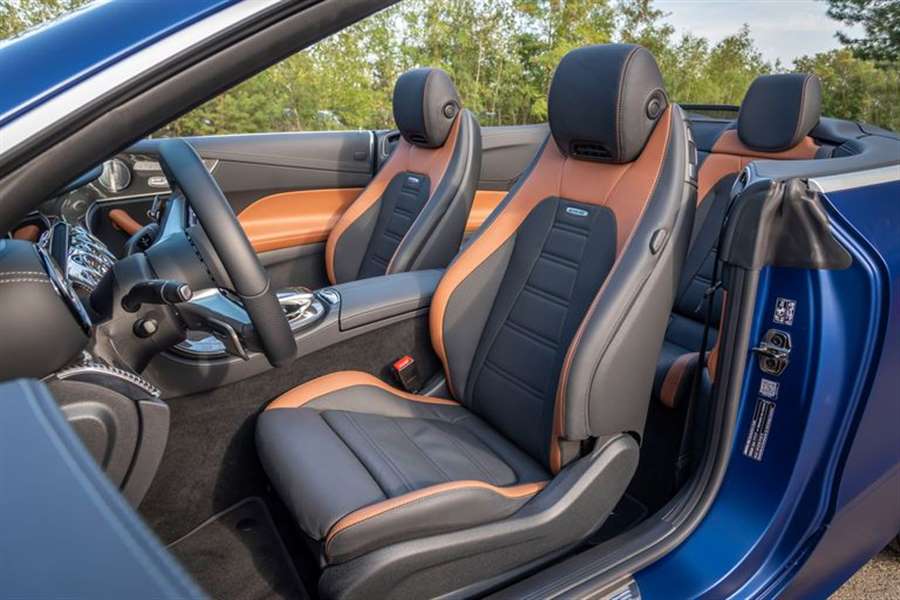
The E53's hybrid powerplant remains almost perfectly suited to the cabriolet's dynamic demeanor—rapid but relaxed, adding character without dominating the experience. Even cruising at speed with the roof folded, the E-class cabrio's cabin is impressively free of drafts or buffeting. The Airscarf system directs hot air to the top of the seats, making it possible to enjoy top-down driving in conditions that would be too chilly for most convertibles. The nine-speed automatic gearbox is also smoother at lower speeds than on V-8-powered models, where AMG replaces the torque converter with a wet-clutch pack.
Luxurious cabriolets have been part of Mercedes's offerings in the United States for as long as the brand has been selling cars here, but that might not be the case for much longer. We know that the future of all the brand's cabrios (and conventional coupes) are under review in the face of sliding sales. Losing a car like this would be a huge shame. The E53 continues to feel like a high point for both its brand and its wider genre.
Source: caranddriver.com
2021 Mercedes-Benz A 250 e AMG Line Premium Review
The numbers alone make the A 250 e hugely appealing as a company car, while the fuel savings and fantastic interior will be just as tempting for private buyers. We hope that the quality issues our test car suffered were an isolated thing, but we would prefer a slightly more forgiving ride. Even so, this PHEV remains one of the highlights of the A-Class range.
We’ve been used to exaggerated fuel economy figures for years, and things don’t seem to have improved with the ranges manufacturers claim for electric cars either. So surely Mercedes’ declaration that its new plug-in hybrid A-Class could average over 250mpg and run on electric power for 44 miles is pie in the sky? Let’s see…
Most plug-in hybrids will struggle to get near the 30-mile mark their makers claim, so 44 miles is quite a challenge. But Merc’s answer is to give its baby a 15.6kWh battery – hidden where you won’t notice (until you fill up the smaller-than-usual 35-litre fuel tank) – and a turbocharged 1.3-litre four-cylinder petrol engine. Total power output is 215bhp, meaning the A 250 e’s 0-62mph time is a swift 6.6 seconds.
But what about those fuel economy figures? Of course, it all depends how you drive, but for our test of the car, we took a varied route over a mix of motorway, fast A-roads and urban stuff – further than the average driver will cover in a day.
We started with a full charge, although the range display only read 34 miles, possibly down to how the Merc had been driven before we got our hands on it. Of the first 30 miles we drove, the read-out showed that 28 of them had been covered on electric power, with the average fuel economy displayed on the read-out at its maximum of 99.9mpg and electric usage at 4.1m/kWh – both pretty impressive.
The range read-out showed 12 miles still to go, too, meaning a theoretical range just two miles shy of the 44-mile claim.
To be honest, if it hadn’t been for us being a bit forceful with the throttle to get the petrol engine to kick in, we suspect a whole 30-mile journey could be covered on electric power – and that means those huge economy claims are almost in reach for a great many people, as long as they plug their car in to charge regularly.
Plus, if your home energy costs no more than 13p per kWh, your first 40 miles will cost you a couple of pounds – less than half what you’d pay in a petrol-powered A-Class.
Then there are the company car tax savings, which will appeal to many. With its 32g/km figure and 44-mile range, you’ll only pay tax on 8 per cent of the P11D value (or just 6 per cent for the basic AMG Line version) versus a whopping 29 per cent for a petrol A-Class. Sure, your company will have to pay at least £32,925 for the cheapest A 250 e, but it could slash your company car tax liability by around a third.
The driving experience is a mixed bag, though. On electric power alone, the car is swift and quiet, as you’d expect. And when the engine kicks in, it doesn’t get that much rowdier unless you’re using plenty of revs, when things can get unpleasantly loud.
However, the throttle is super-sensitive and the lumpy eight-speed dual-clutch gearbox can make you think that the engine is cutting in even when it’s not. In electric mode, the power goes through the eight-speed DCT automatic gearbox, which is jerky going from first to second and feels as though the engine has fired up. You get the same kind of slight tremor you get when an engine cuts in, but it’s actually the gearbox just switching gears.
Really, the engine is only there for when battery power has run out. In most everyday driving situations, electric power will do just fine – even on the motorway at the legal limit. But if you want to match the exciting 0-62mph time, you’ll need to have both power sources working in tandem.
All four versions of the A 250 e come in sporty AMG Line trim levels, but they fail to match the fun of the full-bore AMG models. These aren’t the best A-Classes through bends by a long chalk, but they do an okay job as family transport.
Space is good in the front and back, the doors open wide to reveal decent access, all-round visibility is great, and the 345-litre boot will certainly be big enough for most buyers’ needs.
The A-Class is an easy drive, but not very rewarding: the steering responds okay, but has little feedback from the road, and while the tyres grip okay, they’re noisy – which is amplified by the quiet EV powertrain.
We were more disappointed with the ride, especially as our car had Comfort suspension. It’s not too uncomfortable, but other small hatches ride better.
More of a problem in the test car that we drove was the shiver that ran through the body and the subsequent rattles every time we went over cats’ eyes or hit a mild pothole in the road. It’s certainly not what you’d expect from a Mercedes.
Especially one with what is the best interior in any small car bar none. Our AMG Line Premium model comes in with a price of £35,980 – not too far from a fully electric Kia e-Niro. But as standard the Merc comes with the fabulous, seamless twin 10-inch screens, augmented-reality satellite-navigation that overlays directions on a live feed from a front-facing camera, wireless phone charging and the very latest in smartphone connectivity.
Above all, the cabin looks and feels high-end. There’s heated sports seats with red stitching, multi-coloured ambient lighting, a touchpad to run the infotainment (mirrored by touch-sensitive buttons on the wheel), aluminium trim and turbine vents.
Outside there’s a subtle AMG bodykit, smart 18-inch alloys and LED headlights – all of which doesn’t make the price seem too exorbitant, especially with the potential savings on tax and fuel.
Source: mercedes-world.com
2021 Mercedes-AMG E63 S Does It All (PHOTOS)
AMG's updated 603-hp E63 S is a multi-talented rocket that can play a limousine or a sports car all the way to its top speed.
The V-8-powered sports sedan is rapidly becoming an endangered species, making the arrival of the revised Mercedes-AMG E63 S a timely reminder that there won't be too many more examples of what is one of our favorite automotive genres. AMG has already admitted that its next-gen hybridized powertrain will be based on a four-cylinder engine, and even if that boasts an output to match (or surpass) the 603-hp twin-turbo V-8 in the E63 S, we can't imagine it will get close on character.
But before we call the mortuary, the E63 S remains a spectacularly talented all-rounder, with none of the E-class's midlife revisions having altered its ability to deliver huge, effortless speed. And it was happy to prove this in spectacular style in its most natural European environment—the passing lane of a German autobahn. As traffic cleared on the A13 near Dresden and the dawdlers happy to cruise at a mere 90 mph or so headed right, the AMG proved its ability to deliver seat-squashing g-forces and a heady V-8 soundtrack with a total lack of untoward drama. It felt as though acceleration barely diminished as the speedometer needle swept past 120 mph, where most fast cars begin to really struggle with the wind, and continues to pull strongly even beyond 155 mph, where lesser AMGs suffer the intervention of their electronic governor. We couldn't find a quiet enough stretch to confirm a top speed for the E63 S, but AMG says its more permissive limiter won't call time until 186 mph.
While such antics are fun, they only represent a small part of the E63 S's appeal. This remains a performance sedan as good at everyday speeds as it is at stratospheric velocities, handling the real world with very nearly the same level of refinement as its less powerful siblings, thanks to the transformative effect of its switchable dynamic modes. Comfort mode turns the E63 S into a limousine, with supple air springs and adaptive dampers doing an outstanding job of digesting road imperfections and the nine-speed automatic shifting early to make the most of every last drop of premium gasoline. The peak 627 pound-feet of torque is available between 2500 rpm and 4500 rpm. The gentlest mode is almost too civilized for something so potent, with AMG's engineers admitting they slightly softened the facelifted car's suspension in response to customer feedback.
If we were most buyers, we’d treat the firmer Sport mode as the everyday default, as it puts some pep into the E63 S's responses and some rasp into its exhaust note without adding undue harshness. Beyond that lies Sport Plus, which puts a noticeable edge on the damping, and the full-on Race mode, which turns the AMG into a snarling monster. Adaptive dampers, the switchable exhaust, and ESP modes can all be controlled separately, and there is still a Custom mode for the hard to please.
While the standard nine-speed shifts both cleanly and quickly, its continued use of a multiplate clutch pack instead of a torque converter—to help sharpen responses and enable high-rpm launches—does have a small impact on low-speed refinement, with the sense that engine and wheels are sometimes being connected with too much suddenness.
The E63 S controls its mass exceptionally well, feeling agile and wieldy for something its size and weight. Its curb weight is around 4600 pounds, but the accurate steering has good feel and delivers both arrow-straight high-speed stability and decisive cornering responses. Selecting the more aggressive dynamic modes brings a rearward bias to the torque distribution of the E63 S's standard all-wheel-drive system, but it takes the (likely rare) selection of the car's Drift mode to turn it into a tire-smoking rear-driven hooligan. While we obviously needed to sample this function in the interests of scientific discovery, we suspect that few buyers will use it often. "Aerodynamically optimized" 10-spoke, 20-inch wheels are standard, and the car we sampled also came with the optional carbon-ceramic brakes, an upgrade that provided predictably indefatigable stopping power.
The world might be losing interest in sedans, but—as with the lesser members of its clan—the E63 S has been given a facelift more substantive than the sort of gentle tinkering normally reserved for a midlife sharpening. A new front end features a vertically slatted radiator grille inspired by that of the original 300SL, with the oversize Mercedes star in the center now housing some of the sensors required for the lane-and-distance-keeping Drive Pilot smart cruise control.
As before, the cabin remains spacious, smart, and extremely well equipped, proving that leather and carbon fiber can play nice together. But as with its regular sisters, moving the E63 S onto the latest MBUX infotainment system has created additional complication and a fair amount of ergonomic confusion. Changing horses midstream (as it were) has required the E-class to effectively accommodate two different interface systems. So, the new car keeps the pre-facelift model's rotary dynamic mode selector on the center console, as well as exhaust, gearbox, damper, and stability switches. These functions, however, are all replicated by the two new rotary controllers (with neat integrated screens) mounted to the steering wheel.
The wheel itself features double spokes on each side, these seemingly required just to allow sufficient space for all the controls it now carries. Despite all of this—and the presence of a voice assistant summoned by saying, "Hey, Mercedes"—some common functions remain hidden within the myriad of submenus. This is a car that makes it considerably easier to change damper settings than to select a new radio station.
We're promised that the revised E63 S will be with United States dealers by the end of the year, with a $108,550 base price putting it between the regular BMW M5 and the M5 Competition. The AMG might not have quite the level of focus of its most obvious competitor, but it sounds superior and—thanks to its personality-changing dynamic modes—has a broader spread of talents. Cars such as these won't be available for much longer. We will miss them when they're gone.
Source: caranddriver.com

